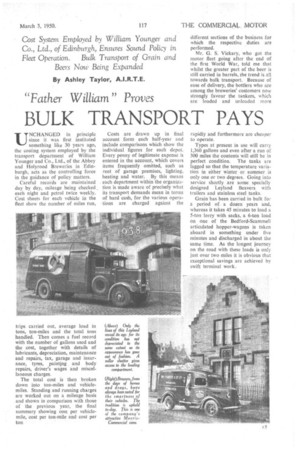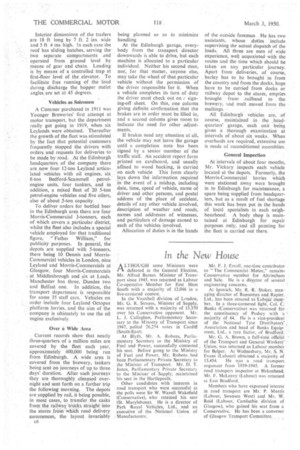"Father William" Proves
Page 41

Page 42

If you've noticed an error in this article please click here to report it so we can fix it.
BULK TRANSPORT PAYS
Cost System Employed by William Younger and Co., Ltd., of Edinburgh, Ensures Sound Policy in Fleet Operation. Bulk Transport of Grain and Beers Now Being Expanded
By Ashley Taylor, A.I.R.T.E.
UNCHANGED in principle since it was first instituted something like 30 years ago, the costing system employed by the transport department of William Younger and Co., Ltd., of the Abbey and Holyrood Breweries in Edinburgh, acts as the controlling force in the guidance of policy matters.
Careful records are maintained day by day, mileage being checked each night and petrol twice weekly. Cost sheets for each vehicle in the fleet show the number of miles run, trips carried out, average load in tons, ton-miles and the total tons handled. Then comes a fuel record with the number of gallons used and the cost, together with details of lubricants, depreciation, maintenance and repairs, tax, garage and insurance, tyres, painting and body repairs, driver's wages and miscellaneous charges.
The total cost is then broken down into ton-miles and vehiclemiles. Standing and running charges are worked out on a mileage basis and shown in comparison with those of the previous year, the final summary showing cost per vehiclemile, cost per ton-mile and cost per ton.
Costs are drawn up in final account form each half-year and include comparisons which show the individual figures for each depot. Every penny of legitimate expense is entered in the account, which covers items frequently omitted, such as rent of garage premises, lighting, heating and water: By this means each department within the organization is made aware of precisely what its transport demands mean in terms of hard cash, for the various operations are charged against the different sections of the business for which the respective duties are performed.
Mr. G. S. Vickary, who got the motor fleet going after the end of the first World War, told me that whilst the greater part of the beer is still carried in barrels, the trend is all towards bulk transport. Because of ease of delivery, the bottlers who are among the breweries' customers now strongly favour the tankers, which are loaded and unloaded more rapidly and furthermore are cheaper to operate.
Types at present in use will carry 1,360 gallons and even after a run of 300 miles the contents will still be in perfect condition. The tanks are lagged so that the temperature variation in either winter or summer is only one or two degrees. Going into service shortly are some specially designed Leyland 13eavers with trailers and stainless steel tanks.
Grain has been carried in bulk for a period of a dozen years and, whereas it takes 45 minutes to load a 5-ton lorry with sacks, a 6-ton load on one of the Bedford-Scammell articulated hopper-wagons is taken aboard in something under five minutes and discharged in about the same time. As the longest journey on the road with these loads is only just over two miles it is obvious that exceptional savings are achieved by swift terminal work.,
Interior dimensions of the trailers are 18 ft long by 7 ft. 2 ins. wide and 5 ft 4 ins. high. In each case the roof has sliding hatches, serving the two separate compartments and operated from ground level by means of gear and chain. Loading is by means of a controlled trap at first-floor level of the elevator. To facilitate free running of the load during discharge the hopper outlet angles are set at 45 degrees.
Vehicles as Salesmen A Commer purchased in 1911 was Younger Breweries' first attempt at motor transport, but the department really got going in 1919, when six Leylands were obtained. Thereafter the growth of the fleet was stimulated by the fact that potential customers frequently stopped the drivers with orders and requests for deliveries to be made by road. At the Edinburgh headquarters of the company there are now four I2-ton Leyland. articulated vehicles with oil engines, six
8-ton Bedfo rd-Scammell petrolengine units, four tankers, and in addition, a mixed fleet of 20 5-ton petrol-engine vehicles and five oilers, also of about 5-ton capacity.
To deliver orders for bottled beer in the Edinburgh area there are four Morris-Commercial 3-tonners, each of which covers a particular district, whilst the fleet also includes a special vehicle employed for that traditional figure, " Father William," for publicity purposes. In general, the depots are supplied with 5-tonners, there being 10 Dennis and MorrisCommercial vehicles in London, nine Leyland and Morris-Commercials at Glasgow, four Morris-Commercials at Middlesbrough and six at Leeds. Manchester has three, Dundee two and Belfast one. In addition, the transport department is responsible for some 35 staff cars. Vehicles on order include four Leyland Octopus platform lorries, and the aim of the company is ultimately to use the oil engine exclusively.
Over a Wide Area Current records show that nearly three-quarters of a million miles are covered by the fleet each year, approximately 400,000 being run from Edinburgh. A wide area is covered from the brewery, tankers being sent on journeys of up to three days' duration. After such journeys they are thoroughly cleansed overnight and sent forth on a further trip the following morning. The depots are supplied by rail, it being possible, in most cases, to transfer the casks from the railway trucks straight into the stores from which road delivery commences, the layout invariably c6 being planned so as to minimize handling
At the Edinburgh garage, everybody from the transport director downwards is able to drive, but each machine is allocated to a particular individual. Neither his second man, nor, for that matter, anyone else, may take the wheel of that. particular vehicle without the permission of the driver responsible for it. When a vehicle completes its turn of duty the driver must check out on r signing-off sheet. On this, one column giving definite confirmation that the brakes are in order must be filled in, and a second column gives room to indicate the need for other adjustments.
If brakes need any attention at all, the vehicle may not leave the garage until it completion note has been signed by a senior member of the traffic staff. An accident report form printed on cardboard, and usually affixed to wood backing, is carried on each vehicle This form clearly lays down the information required in the event of a mishap, including date, time, speed of vehicle, name of driver and other persons, and postal address of the place of accident, details of any other vehicle involved, description of weather and roads, names and addresses of witnesses, and particulars of damage caused to each of the vehicles involved.
Allocation of duties is in the hands
of the outside foreman He has two assistants, whose duties 'include supervising the actual dispatch of the loads. All three are men of wide experience, well acquainted with the routes and the time which should be taken on any particular journey. Apart from deliveries, of course, barley has to be brought in from the country and from the docks, hops have to be carried from docks or railway depot to the stores, empties brought from railhead to the brewery, rind malt moved from the maltings.
All Edinburgh vehicles are, of course, maintained ,in the .headquarters' garage, each unit being given a thorough examination at intervals of about six weeks. When overhauls are required, extensive use is made of reconditioned assemblies.
General Inspection
At intervals of about four months, Mr. Vickary inspects each vehicle located at the depots. Formerly, the Morris-Commercial lorries which were stationed away were brought in to Edinburgh for maintenance, a spare being supplied from headquarters, but as a result of fuel shortage this work has been put in the hands of local specialists in each neighbourhood. A body shop is maintained at Edinburgh for repair purposes only, and all painting for the fleet is carried out there.
































































































